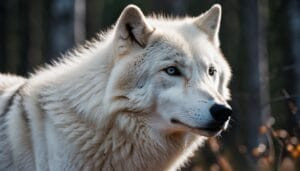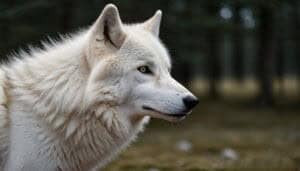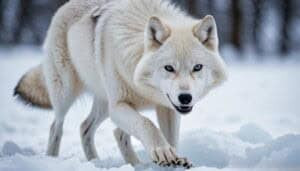Introduction
The Arctic wolf, a master of survival in harsh and frozen landscapes, relies on a combination of sharp instincts and specialized physical traits to thrive. Among these adaptations are its whiskers—often overlooked yet vital sensory tools that play a key role in detecting changes in its environment
Whiskers allow Arctic wolves to sense prey, navigate in low-light Arctic winters, and detect subtle movements that aid in their hunting strategies. This article explores the multifaceted functions of Arctic wolf whiskers, the science behind their sensitivity, and their evolutionary advantages
We’ll also compare these sensory tools to those of other Arctic mammals, shedding light on how whiskers enable the Arctic wolf to excel in extreme conditions
The Arctic Wolf’s Whiskers: An Essential Sensory Tool
Whiskers, or vibrissae, play a fundamental role in many mammals’ sensory systems, and Arctic wolves are no exception. Adapted to survive the harsh Arctic environment, these specialized hairs act as finely tuned sensory tools, helping the wolf navigate, detect prey, and respond to its surroundings
This section delves into the function and importance of Arctic wolf whiskers, particularly in hunting, navigation, and survival. Their sensitivity and placement allow Arctic wolves to remain agile and aware, even in low-visibility conditions like snowstorms or dark polar nights
How Do Whiskers Function as Sensory Organs?
Whiskers on the Arctic wolf are not just simple hairs; they are deeply embedded, thickened structures that connect to specialized nerve endings called mechanoreceptors
These receptors detect even the slightest vibrations or changes in air currents, giving the wolf detailed information about its immediate surroundings. Whiskers can detect nearby objects, movement, and surface textures, which is crucial when visibility is impaired by heavy snow or darkness during the Arctic winter
According to research on wild canids by Bachrach and Frasier (2017), whiskers are highly sensitive due to their attachment to nerve-rich follicles, which makes them 5 to 10 times more sensitive than regular hairs
Each whisker transmits data to the somatosensory cortex in the wolf’s brain, allowing for precise spatial mapping. For Arctic wolves, this heightened sensitivity ensures they can “feel” their environment, even when vision and hearing are insufficient
Whiskers also play a role in tactile exploration. When Arctic wolves encounter unfamiliar terrain or investigate burrows where prey may hide, their whiskers sweep forward—guided by voluntary muscle movements—to sense obstructions or openings
This active whisker movement is a trait shared with other mammals, including domestic dogs, though the sensitivity in Arctic wolves is more pronounced due to their need to detect prey beneath snow or ice
Role of Whiskers in Hunting and Prey Detection
Whiskers are essential to the Arctic wolf’s hunting strategies, particularly when searching for prey buried under snow or moving in dense terrain. Arctic wolves primarily prey on musk oxen, Arctic hares, and caribou, but smaller animals like lemmings and voles often burrow beneath the snow, making them difficult to locate
By sensing minute vibrations and changes in air pressure caused by prey movements, Arctic wolves can pinpoint the exact location of their target
As noted in studies by Grant and Arkley (2016) on mammalian vibrissae, whiskers are capable of detecting disturbances in the environment caused by living organisms up to a certain radius. This ability allows wolves to conserve energy—critical in the Arctic—by reducing unnecessary digging or missed opportunities during hunts
During a hunt, Arctic wolves use whiskers in conjunction with their sharp hearing and sense of smell. When close to prey, whiskers provide immediate feedback on its position and movement
This synergy of senses makes the Arctic wolf an efficient predator, especially when hunting smaller or concealed animals in snowy terrain
Navigating Arctic Winters With Whisker Sensitivity
The Arctic environment poses unique challenges, including long periods of darkness, freezing winds, and heavy snowfall
Arctic wolves must navigate through these conditions with precision to find food, track their pack, or avoid dangers such as cliffs or thin ice. Whiskers act as a secondary set of “eyes,” helping wolves detect obstacles, sense wind direction, and navigate in low-light or blind conditions
Whiskers are particularly useful during polar night, when the Arctic is shrouded in darkness for weeks or months. Without visual input, Arctic wolves rely heavily on vibrissal sensitivity to interpret their environment. Subtle air currents, changes in wind patterns, and vibrations detected through whiskers provide valuable sensory data that compensates for the lack of light
According to Pohl et al. (2019), environmental challenges like wind-blown snow create micro-currents in the air, which whiskers can perceive
By responding to these changes, Arctic wolves maintain a high level of spatial awareness, preventing disorientation and enabling them to navigate the tundra with confidence
Differences Between Arctic Wolves and Other Canids
While all canids possess whiskers, Arctic wolves display adaptations that make their vibrissae particularly suited to the extreme conditions of the Arctic
Unlike domestic dogs or gray wolves, Arctic wolf whiskers are thicker, slightly longer, and positioned to optimize environmental sensing. This allows for greater sensitivity in detecting air currents, vibrations, and objects buried under snow
Another notable difference is the density and placement of whiskers. Arctic wolves have prominent whiskers above their eyes (supraorbital vibrissae) and around their muzzle. These specific placements enhance their ability to detect subtle changes in their immediate vicinity, a crucial trait when dealing with unseen prey
Studies by Mech (1981) on Arctic wolf behavior further emphasize the importance of sensory adaptations, including whisker reliance, for Arctic wolves compared to their relatives
In temperate or forested environments, other canids depend more heavily on vision or sound. However, in the Arctic’s visually obscured landscape, whiskers become indispensable for survival
The Science Behind Arctic Wolf Whiskers
Arctic wolf whiskers are marvels of biology, offering a critical edge for survival in some of the harshest environments on Earth
As sensory tools, they are finely tuned to pick up environmental signals that help the wolf navigate, hunt, and survive in the vast, frozen tundra. This section explores the structure, sensitivity, and adaptations of Arctic wolf whiskers and their role in ensuring energy efficiency
Structure and Sensitivity of Whisker Mechanoreceptors
Arctic wolf whiskers, scientifically known as vibrissae, differ from regular hairs due to their structure and the way they connect to the nervous system. Each whisker is embedded deep within a follicle, surrounded by a rich network of nerves and blood vessels
These nerve endings, called mechanoreceptors, are incredibly sensitive to touch, vibrations, and even minor air movements. This sensitivity makes whiskers an extension of the Arctic wolf’s tactile senses, functioning almost like external antennas that constantly scan the environment
The follicles of Arctic wolf whiskers feature Merkel cells and Pacinian corpuscles, two specialized types of mechanoreceptors. Merkel cells respond to sustained pressure, allowing the wolf to detect steady contact with objects, while Pacinian corpuscles detect fast, fleeting vibrations, such as a small animal moving under the snow
The presence of these cells explains why Arctic wolves can locate prey like lemmings or voles with such accuracy, even when the animals remain hidden beneath layers of snow and ice
According to studies on mammalian whisker sensitivity by Grant and Arkley (2016), the mechanoreceptors found in wild canids like Arctic wolves are more advanced than those in domestic animals
This enhanced sensitivity is likely an adaptation to their extreme environment, where reliance on tactile feedback compensates for limited visual cues caused by snowstorms, fog, or darkness
How Whiskers Adapt to Arctic Environmental Challenges
The Arctic environment is fraught with challenges such as freezing temperatures, strong winds, and prolonged periods of darkness during the winter. Arctic wolf whiskers are uniquely adapted to endure these harsh conditions and provide reliable sensory feedback
Whiskers are coated with a dense keratin layer that prevents damage from frostbite or freezing winds. This protective layer ensures they remain functional even when temperatures plummet well below zero
A key adaptation of Arctic wolf whiskers is their ability to detect minute air current changes caused by environmental obstacles or moving prey. Wind in the Arctic often blows snow across the tundra, creating a sensory obstacle for most animals. However, whiskers can sense how air currents deflect around objects like rocks, ice ridges, or burrowing prey
This tactile feedback allows Arctic wolves to move confidently across the snow-covered landscape, avoiding hazards like thin ice or cliffs that may not be immediately visible
In addition, whiskers play an essential role in conserving energy during hunts. Digging through snow or chasing prey in deep drifts can be energy-draining, which is costly in the Arctic’s harsh conditions where food scarcity is common
By using whiskers to detect prey before expending effort, Arctic wolves optimize their hunting strategies. This adaptation ensures they burn minimal energy while increasing their success rate
The Role of Whiskers in Energy Conservation
Energy conservation is a matter of survival in the Arctic, where food sources are often scarce, and temperatures demand high energy expenditure simply to maintain body heat
Arctic wolves rely heavily on their whiskers to reduce unnecessary movements and target prey with precision. By detecting vibrations and subtle shifts in the snow’s surface, whiskers enable the wolf to make accurate decisions about when and where to dig for hidden prey
Whiskers complement the Arctic wolf’s already exceptional sense of smell and hearing, which also play roles in prey detection. However, when snow muffles sound or blocks scent trails, whiskers become even more critical
For example, as lemmings tunnel beneath the snow, their movements create faint vibrations that travel through the surrounding substrate. Whiskers pick up these signals, allowing Arctic wolves to pinpoint the exact location of the prey and strike with minimal effort
This efficiency is vital for survival in an environment where conserving calories can mean the difference between life and death
Studies by Pohl et al. (2019) on Arctic mammals’ adaptations highlight how tactile sensitivity, particularly in whiskers, aids predators like the Arctic wolf in conserving energy during prolonged food shortages. By reducing trial-and-error hunting and improving accuracy, whiskers contribute significantly to the wolf’s overall energy economy
Scientific Studies on Arctic Wolf Sensory Adaptations
Scientific research has provided valuable insights into how Arctic wolves use their whiskers to adapt to their environment. A foundational study by Mech (1981) highlighted the critical role sensory systems play in wolf survival, particularly in harsh climates
More recent studies by Bachrach and Frasier (2017) expanded on these findings, showing that wild canids possess whiskers with enhanced tactile sensitivity, enabling them to interact with their environments more effectively
Further studies on the comparative physiology of whiskers in Arctic mammals reveal that Arctic wolf vibrissae have a higher density of mechanoreceptors compared to other canids. This specialization allows them to respond rapidly to environmental feedback, whether it’s tracking prey beneath snow or avoiding unseen dangers in low-visibility conditions
The integration of whisker sensitivity with other sensory inputs has been a focus of scientific inquiry as well
Grant and Arkley (2016) demonstrated that whisker information is processed in the brain’s somatosensory cortex alongside visual, auditory, and olfactory inputs, creating a multisensory map of the wolf’s environment. This advanced sensory processing underscores the evolutionary advantage whiskers provide in navigating the Arctic
Evolutionary Advantages of Whiskers in Arctic Wolves
Whiskers, or vibrissae, are one of the most crucial sensory tools for Arctic wolves, offering a unique evolutionary advantage that has allowed these animals to thrive in extreme Arctic environments
Over thousands of years, Arctic wolves have adapted to a frigid and often featureless landscape by developing a highly sensitive tactile system that complements their other senses. Their whiskers provide a survival edge in areas where food is scarce, navigation is challenging, and environmental conditions can often impair vision and smell
This section explores how whiskers contribute to survival, enhance predator-prey interactions, and improve environmental awareness while tracing their evolutionary significance
Survival Benefits in Extreme Conditions
The Arctic tundra is one of the most inhospitable habitats on Earth, characterized by sub-zero temperatures, long polar nights, and wind-swept snowfields
Arctic wolves have evolved to survive this harsh terrain with adaptations such as thick fur, compact body size, and the exceptional sensory abilities of their whiskers. Whiskers allow Arctic wolves to maintain an acute awareness of their immediate surroundings, compensating for impaired senses like vision, which is frequently obstructed by snowstorms, dense fog, or the darkness of polar winter
Whiskers detect minute air movements and vibrations that occur when prey, predators, or environmental objects disrupt the air or snow around them. This capability is particularly advantageous during hunts or pack travel, where avoiding hidden dangers like crevasses, thin ice, or steep cliffs is critical
Mechanoreceptors at the base of each whisker enable wolves to interpret environmental feedback instantly, providing life-saving information about their surroundings
This tactile adaptation also aids wolves during long hunts, where conserving energy is paramount. Arctic wolves rely on their whiskers to ensure efficient prey detection, minimizing wasted effort and movement—an evolutionary advantage that reduces caloric expenditure in a habitat where every meal is essential for survival
Enhanced Sensory Detection for Predator-Prey Interactions
The success of Arctic wolves as predators in a resource-scarce environment is due, in part, to their ability to detect and capture prey with precision. While their acute sense of smell and hearing are vital tools, whiskers provide tactile input that complements these senses
For example, when hunting burrowing animals like lemmings, voles, or Arctic hares hidden beneath thick snow layers, whiskers enable Arctic wolves to detect subtle ground vibrations caused by prey movement. This allows them to pinpoint prey without excessive digging, a process that saves both energy and time
Predator-prey interactions are highly dependent on environmental awareness, and whiskers enhance a wolf’s ability to close in on prey silently
By sensing shifts in air currents or terrain feedback, Arctic wolves can approach targets without disturbing their environment. This silent hunting strategy is a product of evolutionary refinement that maximizes success rates while conserving energy
The evolutionary significance of whiskers in Arctic wolves is reinforced by their role in group hunts. Pack behavior in Arctic wolves often requires tight coordination and spatial awareness among members. Whiskers provide wolves with sensory cues about the positions and movements of other pack members, allowing for seamless cooperation during pursuits of larger prey like caribou or musk oxen
This enhances the efficiency and success of group hunts, a critical advantage for survival in the harsh Arctic ecosystem
How Whiskers Improve Environmental Awareness
In addition to hunting, whiskers play an essential role in improving Arctic wolves’ environmental awareness. This is particularly important in a landscape devoid of landmarks, where visibility is often poor. Whiskers act as tactile sensors, allowing wolves to detect obstacles, changes in terrain, and the presence of ice cracks or snow drifts
By analyzing subtle air current variations caused by these features, Arctic wolves develop a “map” of their immediate environment. This adaptation helps them traverse vast, icy landscapes without injury or disorientation
The whiskers above the wolf’s eyes, known as supraorbital vibrissae, are especially useful for environmental awareness. These whiskers can detect objects at head height, such as branches, rocks, or snowbanks, providing instant feedback to the wolf’s brain. Combined with the whiskers around their muzzle and cheeks, this tactile information creates a comprehensive picture of the surrounding environment
The use of whiskers for environmental awareness is most evident during the polar night, a period of prolonged darkness lasting up to 24 hours a day. During these weeks or months, Arctic wolves experience near-total visual impairment, making whiskers indispensable for navigation and hunting
This evolutionary adaptation ensures that wolves remain highly aware of their environment, enabling them to move with confidence despite the extreme conditions
Evolution of Whisker Adaptations Over Time
Whiskers have long played an essential role in the evolutionary success of mammalian predators. For Arctic wolves, the refinement of whisker sensitivity is an adaptation that has allowed them to thrive in their unique environment
Over time, selective pressures such as extreme cold, low prey availability, and challenging environmental conditions favored wolves with highly functional sensory tools, including advanced vibrissae
Evidence from comparative studies on wolves and other Arctic mammals suggests that Arctic wolf whiskers have evolved to be more robust and sensitive than those of their temperate-zone counterparts
According to studies by Pohl et al. (2019), this evolution was driven by the wolves’ need to rely heavily on tactile feedback in an environment where visual and olfactory senses are often compromised
Moreover, whisker adaptations in Arctic wolves share similarities with those observed in other Arctic predators, such as polar bears and Arctic foxes
These mammals, despite their differences, have all developed specialized vibrissae to improve their ability to hunt, navigate, and survive in extreme cold. This convergence of adaptations highlights the evolutionary importance of whiskers as tactile sensors in Arctic ecosystems
Comparison to Other Arctic Mammals’ Sensory Tools
While Arctic wolves rely heavily on their whiskers to navigate and hunt in their extreme environment, they are not the only Arctic mammals to develop specialized sensory tools for survival
Other predators and animals living in the frigid Arctic, such as polar bears, Arctic foxes, and seals, have also evolved adaptations that allow them to thrive in similar conditions
Comparing the Arctic wolf’s whiskers to those of other mammals highlights the diversity of sensory strategies used to overcome challenges posed by this harsh ecosystem
How Do Polar Bears and Arctic Foxes Use Their Whiskers?
Polar bears, like Arctic wolves, rely on their vibrissae to sense environmental changes and detect prey. Their whiskers are large, thick, and highly sensitive, aiding in their survival as apex predators
Polar bears hunt primarily for seals, which are often concealed beneath ice. When a seal surfaces through breathing holes or causes slight vibrations under thin ice layers, the polar bear’s whiskers detect these subtle disturbances, guiding the bear to its target
While Arctic wolves focus their whisker sensitivity on land and shallow snow layers, polar bears extend this functionality to aquatic environments. The bear’s whiskers help them “feel” changes in water currents while swimming, a unique adaptation for hunting seals in icy waters. This dual function—on land and in water—demonstrates how whiskers are critical for tactile awareness across diverse habitats
The Arctic fox, a smaller predator, also uses its whiskers to detect prey concealed beneath snow. Like Arctic wolves, foxes hunt rodents such as lemmings that burrow beneath the snowpack
Arctic fox whiskers are shorter than those of wolves but are similarly sensitive to vibrations caused by prey movements. Foxes also rely on their whiskers when tunneling through snow or maneuvering in tight spaces where their vision is restricted
Differences in Sensory Function Across Arctic Species
Although whiskers are common among Arctic predators, there are notable differences in their structure and function depending on each species’ ecological role. Arctic wolves, as pack hunters, use their whiskers to coordinate movements during group hunts and navigate open tundra where visibility is poor
The placement of their vibrissae, including above the eyes, on the muzzle, and around the cheeks, maximizes their ability to sense prey, pack members, and environmental obstacles
In contrast, polar bears’ whiskers are adapted for solitary hunting, where detecting prey underwater and on ice is critical. Their whiskers are more robust and slightly longer, making them better suited for interpreting underwater pressure changes and air movements near seal breathing holes.
Seals, another important Arctic mammal, have taken whisker sensitivity to an even higher level. Their vibrissae, known as sinusoidal whiskers, are highly specialized to detect minute changes in water movement, which helps them evade predators like polar bears and hunt for fish under dark, icy waters
Seal whiskers have unique ridges that reduce water resistance and improve their ability to detect hydrodynamic disturbances—an advanced adaptation not present in land predators like Arctic wolves and foxes
Why Arctic Wolves Rely More on Whiskers for Navigation
Arctic wolves face unique challenges in navigating their environment, particularly during winter months when darkness, snowstorms, and featureless landscapes dominate their habitat
Compared to Arctic foxes and polar bears, wolves are far more dependent on their whiskers for terrestrial navigation. While polar bears often use their sense of smell and aquatic adaptations to locate prey, and Arctic foxes rely on hearing in combination with whiskers, Arctic wolves combine tactile sensitivity with movement and coordination within their packs
Wolves’ whiskers play a central role in enhancing spatial awareness during pack movements. For example, when traveling at night or during snowstorms, wolves often rely on vibrissal sensitivity to detect environmental changes, obstacles, or the movements of nearby pack members
This sensory reliance helps maintain pack formation and improves hunting efficiency, as wolves can coordinate their movements even when visual cues are absent
Additionally, Arctic wolves hunt larger prey, such as caribou and musk oxen, which requires precision and teamwork
Whiskers provide feedback during close encounters, allowing wolves to gauge the distance and position of prey during a chase or an attack. This function is less prominent in solitary predators like polar bears, which primarily hunt smaller, individual targets
Shared Adaptations Among Arctic Carnivores
Despite their differences, Arctic wolves, polar bears, and Arctic foxes share a common reliance on vibrissae to overcome sensory challenges in the Arctic
Whiskers act as versatile tools that bridge the gap when vision, smell, or hearing is insufficient due to environmental conditions. This shared adaptation underscores the evolutionary significance of vibrissae among Arctic mammals
Research by Pohl et al. (2019) on sensory adaptations in Arctic predators highlights how convergent evolution has led to similar whisker functions across species
Although each animal has tailored its vibrissae to suit its specific ecological niche—wolves for land-based navigation and hunting, polar bears for ice and aquatic hunting, and seals for underwater prey detection—the fundamental role of whiskers as tactile sensors remains consistent
This convergence of adaptations reflects the harsh realities of Arctic survival, where sensory input can mean the difference between life and death. For Arctic wolves, whiskers have evolved into finely tuned instruments that enhance navigation, hunting efficiency, and pack coordination, offering a survival edge in one of the planet’s most unforgiving environments
Conclusion
Arctic wolves’ whiskers serve as a vital adaptation for survival in the unforgiving Arctic environment, enabling them to navigate, hunt, and respond to their surroundings with precision
These specialized vibrissae, connected to highly sensitive mechanoreceptors, allow wolves to detect subtle air currents, ground vibrations, and changes in their environment, even when visual and auditory cues are limited. Whiskers play a critical role in prey detection, particularly when animals like lemmings or voles remain hidden beneath layers of snow
Additionally, they enhance the wolf’s spatial awareness, aiding navigation across snow-covered tundra, and improving pack coordination during group hunts
Compared to other Arctic mammals, such as polar bears, Arctic foxes, and seals, Arctic wolves’ whiskers are uniquely adapted for terrestrial survival, offering advantages that compensate for environmental challenges like darkness, snowstorms, and food scarcity
These tactile tools are a product of thousands of years of evolutionary refinement, underscoring their importance in the wolf’s ability to thrive where few other predators can. The whiskers of Arctic wolves exemplify nature’s ingenuity, providing a powerful sensory edge that ensures survival in one of the world’s most extreme habitats











